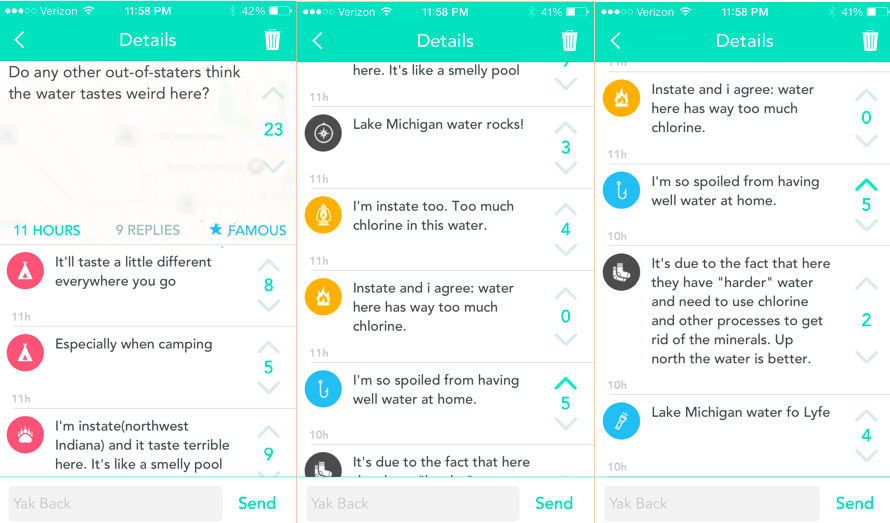
Place:
Examine the layers of geographic location
Yik Yak harnessed the anonymous message board platform of sites like 4chan and linked it to mobile devices, creating a user experience crafted around geographic location. Though we might initially think of location in the simplest terms of geographic coordinates, place is, as Nathaniel Rivers (2016) illustrates, much more complex: there are layers of personal, social, and cultural meaning infused into geographic place, layers that interact with one another to influence our perceptions of these places. One way of engaging with place is through the locative media applications on our phones, which "[augment] the places that come to be (re)constituted by the experiences made possible through that media" (p. 583); that is, users of mobile technologies shape (or reshape) geographic place as they engage in the network associated with that place.
According to Jason Swarts (2015), it seems that this relationship between location and technology has culminated in a "paradox" where we are no longer tied to locations to use our communicative media, even as we are increasingly influenced by the locations read by these gadgets (big data, location-mapping, and yes, even localized social media feeds). Yik Yak was positioned at the point of this paradox: the application did provide users with the opportunity to connect with others outside of face-to-face interactions, but those users still had to be within a specific geographic radius to be on the local feed (which was the primary feed available to users). Somewhat counter to idealizations of the "World Wide Web" that connects everyone and anyone, John Carroll, Blaine Hoffman, Kyungsik Han, and Mary Beth Rosson (2015) argued that digital infrastructures have the capacity to be "hyperlocal." This means that information about events within a particular area can be directly shared with people in that area via their mobile devices, allowing for "rich and reciprocal interactions anchored in familiar community locales." Many of us navigate these infrastructures daily as we use applications on our phones: for example, Yelp provides search results based on a user's location, and Facebook public event pages will show up as "near you" when a user searches the platform. Geofilters available in Snapchat (as seen below, right) are another example of this hyperlocality, allowing users to catalog special events and trips through using these filters to brand their photos, linking them explicitly to geographic locations.
Using location data gathered from mobile devices, Snapchat provides users with a localized experience when they open up the application: first, they have access to filters that are only available in certain locations (and in some cases, at certain times or during special events); and second, they have the opportunity to post their stories to a collaborative feed that again, is attached to either a geographic place, a specific event, or both. To the right are two screenshots, both of which show geofilters that can be used when a user is on Purdue's campus (or at least were used in Spring 2017). Though users build networks in more traditional ways (through pre-existing social circles, integrated into the application through contacts in one's phone or social media accounts) and can share their photos with others, wherever they might be, their photos take on a local flavor with the use of geofilters. These location-based applications, or applications with location-based features, position geographic place at the forefront of user experience. This positioning emphasizes geographic place as a key aspect of digital networking, often overlooked when using platforms that focus on individual profiles or pages.
Yik Yak created such a digital infrastructure by providing a hyperlocal experience for its users through its localized feeds. Despite the possibility for students to discuss location in simplistic ways, given that the application’s design provided strict geographic boundaries for the feed, student work from this study points to the layered nature of location, as they identified the influence of past experiences, as well as local and regional identities, on their understandings of place.
Connections Between Place and Past Experiences
One common linkage that emerged in student reflections was between place and time, illustrating the interplay between different situational factors. For example, over half of the students in this study pointed out the popularity of weather-related posts on the Purdue Yik Yak feed. While most just mentioned this and moved on, Crystal seemed especially interested in the prevalence of this admittedly mundane topic. She wrote, "I think the most primary reason for this phenomenon is that weather is close to our daily lives and is common for everyone. People have different backgrounds and have different experiences of their hometown’s weather. But when they move to West Lafayette, like cultural shock, they have feelings about the current weather." So, even though students were describing weather in similar ways ("It’s cold," or "It’s snowing."), Crystal pointed out that their experience of the weather was largely determined by their past—where they grew up or lived before, signaling the complexities of a topic as commonplace as weather. Several students pointed to this connection, posting about location in ways that referenced their prior experiences and locations. For example, Jeff posted about the quality of drinking water in northern Indiana.

In these screenshots (at left), Jeff asks if other "out-of-staters" think that the water in the area surrounding Purdue University tastes weird, and receives a variety of responses (mostly in agreement: "I'm instate too. Too much chlorine in this water," and "Instate and I agree: water here as way too much chlorine.")
These users suggest that the taste of water around campus is lackluster: a fact that both in-state and out-of-state students seem to agree on in this example. These responses represent a number of different views, but as with the weather, we can clearly see how a user’s present sense of place is influenced by other locations that they have inhabited, clouding a simple understanding of geographic location. These assumptions are assumedly built upon as users interact with one another, learning what the experiences of others have been, as well, contributing to the "stickiness" (Ahmed, 2014) of these experiences and associated feelings.
Using Campus and Local Knowledge to Engage Fellow Users
In addition to seeking common ground through realities tied to geographic location, like weather or amenities, students also noticed and posted content that pointed to campus-specific icons. Reflections included nods to features unique to Purdue, such as particular bus routes, apartment complexes, academic buildings and campus landmarks (including the many fountains that grace our campus), and even the tornado sirens that are tested monthly. Students also engaged with local establishments off campus grounds: Alison decided to post a series of Yaks about going out to the bars during the week and named specific establishments near campus that undergraduate students are known to frequent. In her reflection, she included her yaks about this topic, which were:
- What's so special about the cactus? Never been before.
- Cactus anybody?
- Where else besides Where Else??? #thirstythursday
- Best place to go for Thirsty Thursday?
- This thirsty Thursday in going to be much needed after that exam!
The Cactus and Where Else are popular bars near campus, and Alison referenced these businesses in particular because they are often mentioned on Yik Yak. (She also wrote in her reflection: "I am not 21 and these were only done for research purposes," a disclaimer that fit along with the self-framing of many students who chose "safe" topics to talk about for the assignment.) Alison explained, "The main purpose for me choosing this approach is to see how a yak about location would affect responses and up/downvotes. A difference [I’ve] seen with this segment of posts is that I got more responses. It seems that with location based yaks, people are more responsive mostly because you are asking for their opinion and engaging with the audience." Alison noted the potential for hyperlocal posts to foster engagement on the application, but I would add that this engagement is directly dependent upon membership of other users in the both the cultural and topographical space of Purdue’s campus. For example, someone that was just passing through town and hopped on the feed wouldn’t necessarily understand the references with the same intensity as a Purdue student or another established member of the network. So, feelings of membership in the Yik Yak community were directly linked not only to location, but familiarity with the location: despite the technological ease that someone might have in accessing the Purdue feed, they might not truly be able to engage if they weren’t familiar with the Purdue-specific topics and terms.
Meshing Common Content and Regional Identities
Beyond the campus perimeter, or in some cases, because of it, students also noted the presence of posts that appealed to collective cultural and regional identities. For example, many students referenced posts that were geared towards Indiana University, Purdue’s in-state rival. Rachel wrote that, even if an anti-Indiana University post lacked originality, "it will still get up-votes just because of the hatred towards the school down south." Rachel was not the only student who keyed into this reoccurring kind of post. Amanda composed one as part of her project, commenting on academics at Purdue and Indiana University to combine themes that she often saw on the feed.

At left, Amanda makes a quick comparison between Indiana University and Purdue University to engage with others on the network through humor and an assumed shared sense of school pride. This post represents a potential conflict between Purdue and IU students, if it was shared in mixed company: but since it was posted on Purdue’s local feed, directed towards users that would ideally relate to it, it received quite a few upvotes. If this yak had been posted on the feed on Indiana University’s campus, however, it would have undoubtedly signalled an interruption in relatedness with that audience, and would probably have been downvoted off the feed. Any Yik Yak feed around a college campus featured posts with similar rhetorical strategies, suggesting the importance of regional and cultural understandings of place when considering content from applications organized according to geographic coordinates. These strategies are present on other platforms that can be customized around geographic or cultural locations as well, such as "confessions" or "secrets" Facebook pages, which exist for many institutions (Purdue included).
At first glance, the geographic restrictions of Yik Yak seem to be a simple, if not important, aspect of the application. However, when we consider the layers of meaning that accompany physical place, the hyperlocality provided by this application becomes a more complicated aspect of using it. Eric Gordon and Adriana de Souza e Silva (2011) concluded that, "Location matters, but our locations are now embedded within networked connections. And the social interactions motivated by those connections are part of our locations" (p. 79). Applications like Yik Yak, which provide users with an experience encapsulated in a mesh of factors, can help us to better understand how different compositional factors influence our behaviors, and how these factors are intertwined. Rhetorical ecologies "involve social but also environmental structures that both powerfully constrain and also enable what writers are able to think, feel, and write" (Syverson, 1999, p. 9). When our students use applications like Yik Yak, they actively construct, but are also constrained by, these structures, as well as those who inhabit these structures alongside of them. Asking students to reflect on these experiences encourages them to consider how notions of place are constructed beyond geographic parameters, and to think about how they actively shape collective understandings of place as they write to others that share their local spaces.








